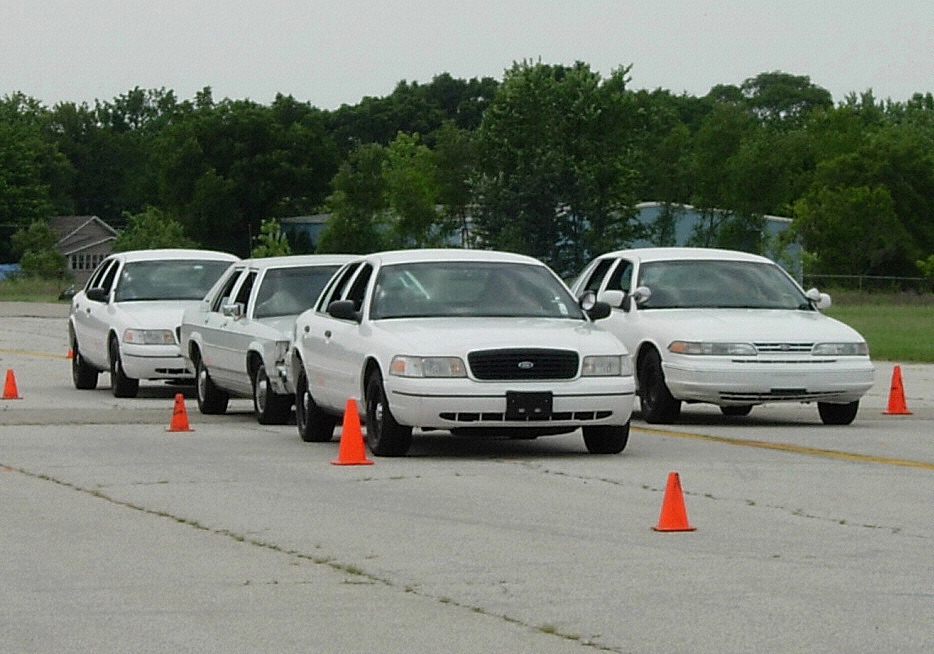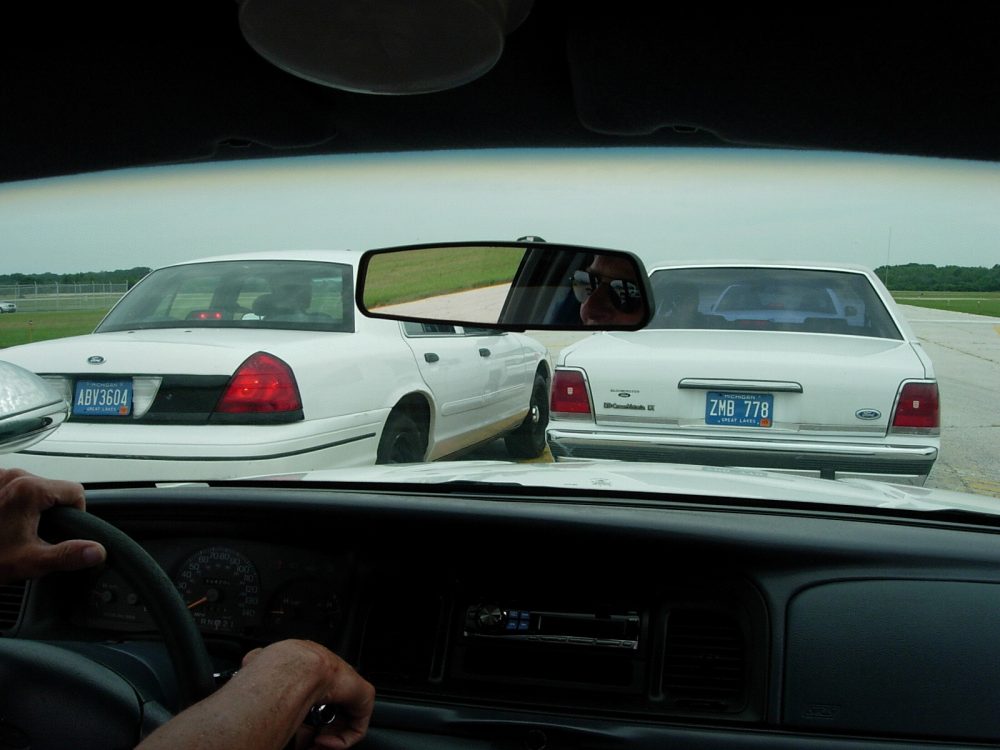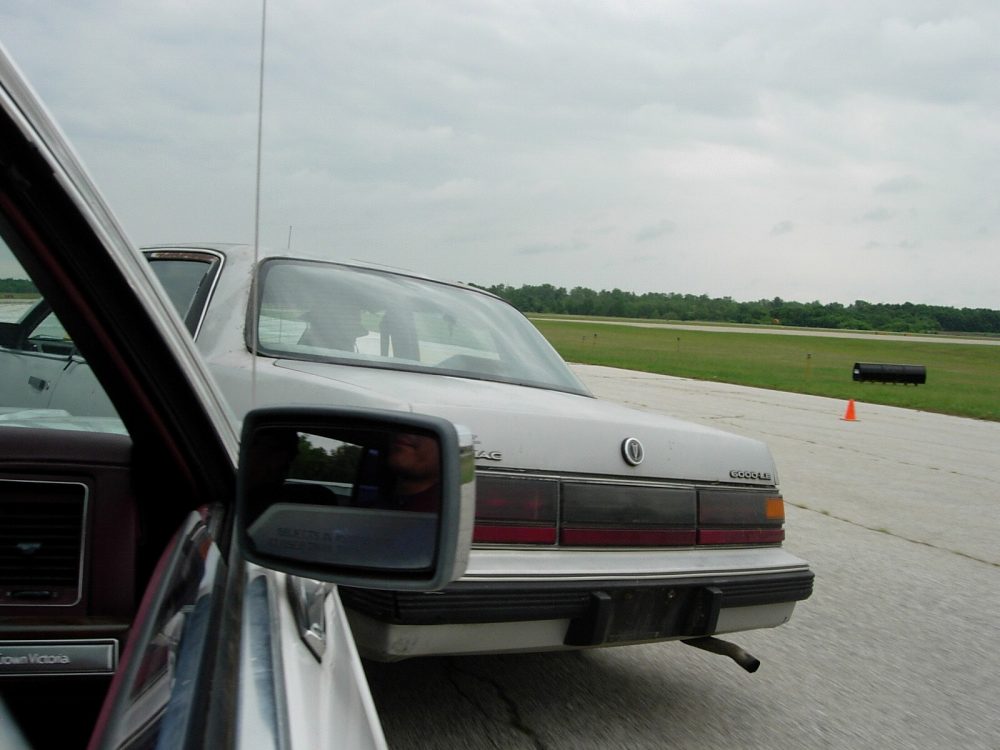I accelerate to overtake the suspect’s vehicle. The gap between us closes and I lift off the gas. Steering carefully, I ease to the right so the front bumper of my Crown Victoria gently kisses the side of his rear bumper. On feeling contact, I cut the steering wheel sharply right and press hard on the gas. As if it suddenly hit a patch of ice, the suspect’s vehicle spins out to the left as I veer right. There is no smashing or crashing, no violent action, just a smooth application of physics and geometry.
Three “patrol” cars perform rolling roadblock to box in suspect’s vehicle, the older model Crown Vic. This maneuver requires careful coordination of all three participants in order to create escape proof block.
“How did it feel?” asks Adam Bhatti, the Crossroads instructor riding with me. Still in shock that the P.I.T. (Precision Immobilization Technique) maneuver can be accomplished so easily, and with a big grin on my face, all I can manage to say is “amazing.” In fact, “amazing” pretty much sums up my week-long experience with Crossroads Training Academy.
Crossroads Academy provides expert instruction in defensive and protective driving skills for emergency vehicle operators, law enforcement and military personnel, as well as private security specialists. The class I’m attending in Benton Harbor, Michigan, is a Professional Development Program for instructors. “We are really going after the law enforcement market,” Director of Operations Nate Foster explains. “Small departments with limited budgets and resources have a need for a credible driving program that will stand up well in court.” This instructor development class is designed so graduates can create a driving program regardless of the size facility available, using a minimal amount of equipment, and with a system allowing objective scoring of the participants. With Crossroads’ program, Nate stresses, “A training officer is able to safely use his department’s regular patrol vehicles without worrying about damaging them—all he needs to worry about are the tires.”
Everyone knows a vehicle can do three things—go, stop and turn—but most drivers only utilize about 40% of their vehicle’s potential to perform these actions. Of the three elements involved — the vehicle, the environment and the driver — 90% of all accidents are due to driver error. A couple of mph too fast, applying the brakes late or a hesitant input on steering, and you become a statistic in a report or an unwilling participant in a funeral. Crossroads graduates learn to blend the acceleration, braking and steering qualities of their vehicle into a seamless package, enabling them to operate at 80% of the vehicle’s capability. Why only 80%? Operating all out at 100% of a vehicle’s potential leaves no room to compensate for driver error or unexpected road hazards.
View from rear car of three-car roadblock. Suspect vehicle has no room to escape.
Table of Contents
MATH WHIZZES
Day one of the instructor course is spent in the classroom diving into the theory of vehicle dynamics. Crossroads is an affiliate of Tony Scotti Associates, and the Scotti program is based on engineering principles—the science of physics and geometry. You may hate math, but it’s a necessary evil for understanding how a vehicle performs, especially if you want to teach others. Developing a driving program is a lot more complicated than just tossing out a bunch of cones and letting students race around them.
The formulas developed by Scotti allow instructors to lay out courses proportional in size to the area they have to train in, plus calculate the ideal time and speeds for scoring. Drivers learn exactly what they are doing correctly, how much of their vehicle’s capabilities they are using and why mistakes occur. The first key to success is to think of speeds in terms of feet-per-second instead of miles-per-hour. To convert mph to fps, you multiply the mph by 1.5. Traveling at 30 mph, you are moving 45 feet per second.
View from pursuit vehicle performing P.I.T. maneuver. As contact is made, driver accelerates and cuts steering wheel sharply, causing suspect’s vehicle to spin out of control.
Now consider how this relates to reaction time. Using a simple example from Tony Scotti’s book, Driving Techniques For The Professional & Non-Professional, say you are traveling at 30 mph, 30 feet behind another vehicle moving at the same speed. As you approach an intersection, the light turns yellow and the driver in front slams on his brakes, coming to a sudden halt. It takes about 55 feet for that car to stop. Now only 70 feet separate the front of your vehicle from the rear of his car. If you’re really paying attention and your reaction time is fast, it takes you close to a second to react. You’ve traveled 45 feet or more before ever applying the brakes, and it will take another 55 feet to come to a stop. That’s a total of 100 feet. You’re about 30 feet short—“Houston, we have a problem.” Prepare yourself for the sickening sound of steel colliding with steel.
Since this is an instructor course, the first actual driving we do is to run each vehicle, all Ford Crown Victorias, through a series of “norming” drills. This provides the acceleration and braking qualities of our cars. This data and the dimensions of each driving course are plugged into the math formulas to compute that car’s potential performance. Now we know the speed each car can run through a drill and the time required to complete the exercise using 80% of the car’s capabilities. With this information we’re ready to measure and lay out cones for the straight lanes, corners and curves of the various drills. If you have limited space, you can reduce the size of the layout, then use those numbers in your equations to determine the speeds and times expected for that size course.
Lamar Jaggears, instructor with the Gadsden, AL, P.D., drives through slalom course. Hand position on steering wheel is critical, and the 3 and 9 o’clock positioning allows aggressive steering inputs without having to reposition your hands.
TRAINING WHEELS
We set up and run a total of eight different courses for score. First, we ride along with instructors at the wheel, watching and learning. Then a series of practice passes, starting at half speed and working up to full speed, prepare us for our scoring runs. For scoring runs, speed and time are critical. Go too slow and points are deducted. Too much speed, force the car out of control and hit cones, lose points. Late on steering inputs, hit cones, and points are lost. Although some drills only involve speeds of 26 mph, it’s amazing how difficult the courses are. “I never thought I’d be this excited about going 26 miles an hour,” remarks student Lamar Jaggears, instructor for the Gadsden, Alabama, P.D.
A Lane Change exercise simulates evasive action to avoid an obstruction in your path and also tests reaction times. For this drill, you are traveling at 36 mph (that’s 54 fps), and a light on the right or left side of the course indicates which lane to choose. You execute your lane change to avoid the obstruction, a wall of cones, and then quickly cut back into your lane. This may not sound difficult until you realize the time provided to make your decision and perform the lane change is one second, and you only have 50 feet, roughly another second, to get back into your original lane of travel. It’s a lot like “whack-a-mole” only at high speeds in a car.
Obstacle Course combines many individual drills into one continuous run that tests all skills worked on during week-long class. Although course only takes about 75 seconds to complete, it is mentally and physically demanding.
The class also includes a low-light session. The course is fairly simple, but in the dark it’s easy to become confused on direction or “outrun” your headlights. The average low-beam headlights provide around 150 feet of vision, which is exactly the distance between the cones we are using as corners. At 50 mph—75 fps—it’s easy to come into a turn too fast. You brake hard to execute a 270-degree turn. To make up for time lost, you hammer the gas pedal and the whole jerky cycle begins again. Consistency is the key. Accelerate smoothly, use the brakes properly and apply fluid, but aggressive steering inputs and it all happens seemingly without effort. Lose your concentration for even a fraction of a second and you’re in trouble with no time or distance to correct or compensate.
After driving each drill separately, we construct an obstacle course combining most of the drills into one continuous run. The obstacle course is scored on time, with points deducted for mistakes such as hitting cones or taking a wrong turn. By now you feel like you’ve been in a week-long nonstop car wreck. Your back, legs, shoulders, arms and hands are sore, and your mind is jelly from working the math involved and concentrating on the driving. Each day is as physically and mentally demanding as any firearms course I’ve attended.
For Lane Change exercise, instructor hits switch to power left or right light, indicating direction to steer in order to avoid wall of cones. With distance and speed involved, you have about one second to react, avoid the obstacle and then cut back into your original lane of travel.
MAN MELDS WITH MACHINE
The final two days contain evolutions on rolling roadblocks, stopping a suspect vehicle using a single car and three-vehicle formations, and Precision Immobilization Techniques (PIT) maneuvers. At this point, the students are becoming one with their cars. It may sound silly, but you have to feel what is happening with your car using sensitivity and awareness. and An intimate understanding of the relationship between speed and distance is required. Decisions are made at a subconscious level. The conscious mind can only focus on one thing at a time, while the subconscious is able to truly multitask, accomplishing a variety of tasks at the same time. A 90-degree turn at high speed, performing a rolling roadblock or a properly executed PIT maneuver should be like a carefully choreographed ballet of vehicles, nothing like the crashing and destruction seen in movies. Unbelievable as it may seem during the whole week of training, nobody’s car ever flips over and explodes into flames!
Adam Bhatti provides last minute instruction to driver before they start night run obstacle course. In the dark it’s easy to become confused on direction or to “outrun” your headlights.
CROSSROADS’ CREDENTIALS
The instructors determine the quality of any class, and the Crossroads staff is exceptional at what they do. The lead instructors for our class, Nate and Adam, started out in this business as kids setting up cones for Tony Scotti. Instructors Dean Simko and Saul Medrano, both ex-military, are also on hand providing their expert instruction. One reason all these guys are such effective instructors is their experience as protection specialists. Crossroads is a subsidiary of Seventrees, a security corporation operating out of Benton Harbor, and the instruction and driving drills are based on time spent working high-risk security assignments. The Crossroads’ motto, “Where you earn your certification,” reflects the staff’s dedication to what they are teaching.
Crossroads offers instruction in several locations in two- to five-day formats that cover an array of vehicle-related subjects. Although their ultimate goal is to teach students to identify and evaluate potential problems before they develop, we know real life doesn’t always cooperate. When trouble is unavoidable, Crossroads provides the skills necessary to evade or drive through dangerous situations.
Whether you are a patrol officer working the streets, a protection specialist responsible for the safety of your client, a soldier navigating a hostile environment full of IEDs and ambushes or just a regular guy trying to make it to the supermarket and back, the skills provided by Crossroads increase your probability of success and survival.
[Tiger McKee is director of Shootrite Firearms Academy, www.shootrite.org.]
SOURCE:
Crossroads Training Academy
Dept. S.W.A.T.
2181 M139 South
Benton Harbor, MI 49022
(269) 925-9039
www.crossroadstrng.com












